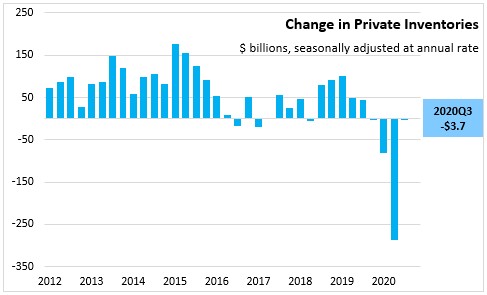The Economics and Statistics Division maintains archives of previous publications for accountability purposes, but makes no updates to keep these documents current with the latest data revisions from Statistics Canada. As a result, information in older documents may not be accurate. Please exercise caution when referring to older documents. For the latest information and historical data, please contact the individual listed to the right.
<--- Return to Archive
For additional information relating to this article, please contact:
December 22, 2020US GDP 2020 Q3 (THIRD ESTIMATE) 
The Bureau of Economic Analysis (BEA) released the Q3 2020 US Real Gross Domestic Product (GDP) "third" estimate today. The GDP estimate released today is based on more complete source data than were available for the "second" estimate issued last month. The US economy grew 33.4% in Q3 after a decline of 31.4% (seasonally adjusted annualized rate, chained 2012 dollars) in Q2 2020. Q3 GDP was revised upward primarily on larger increases in personal consumption expenditures (PCE) and non-residential fixed investment. The increase in Q3 reflects business reopening and resumed activities after more severe COVID-19 restrictions in Q2. BEA also noted that the full economic effects of the COVID-19 pandemic cannot be quantified in the GDP estimate because the impacts are generally embedded in source data and cannot be separately identified. The US economy in Q3 2020 was 2.8% smaller than in Q3 2019.
Increases in GDP for Q3 came from positive contributions from personal consumption, private inventory investments, exports, non-residential and residential investments. Government spending was down at the federal and state and local levels.
Personal consumption expenditure growth was revised upwards to 41.0% in Q3 (in real terms at an annualized rate) following decreases of 33.2% in Q2 and 6.9% in Q1. Services growth was led by increases in health care and food services, while goods were up from sales of motor vehicles and parts, and clothing and footwear. Personal consumption expenditure was 2.8% smaller in Q3 2020 compared to Q3 2019.
Residential investment activity was up 13.0% over Q2, mainly reflecting increases in brokers' commission and ownership transfer costs. Residential investment activity in Q3 was 7.2% above Q3 2019 levels. Growth in non-residential fixed investment was led by the increase in transportation equipment.
Export growth was 59.6% in Q3 (real terms at annualized rates) following declines of 64.4% in Q2 and 9.5% in Q1. Export growth primarily reflected higher goods shipments, led by vehicles, engines and parts and capital goods. Compared to Q3 2019, goods exports were 9.3% lower and service exports were 24.0% lower in Q3 2020.
US nominal GDP increased at an annual rate of 38.3% in Q3, following declines of 32.8% in Q2 and 3.4% in Q1. The personal consumption expenditure price index increased 3.7% compared to a 1.6% decrease the previous quarter.


A seasonally adjusted annualized rate shows what the percent change would be if the quarterly rate continued for four quarters. It is computed by compounding the quarterly rate for four quarters. Reporting annualized rates facilitates comparability between annual and quarterly growth, but can exaggerate change when series are volatile. The COVID-19 shocks do not indicate a contraction of US GDP by 31.4% in Q2 or expansion of 33.4% in Q3. It would take four quarters of compounded contraction or expansions at the same pace as reported for the US GDP to change by these amounts. Real GDP contracted 9.0% in Q2 2020 compared to Q2 2019, and 2.8% in Q3 2020 compared to Q3 2019.
Source: US Bureau of Economic Analysis
<--- Return to Archive